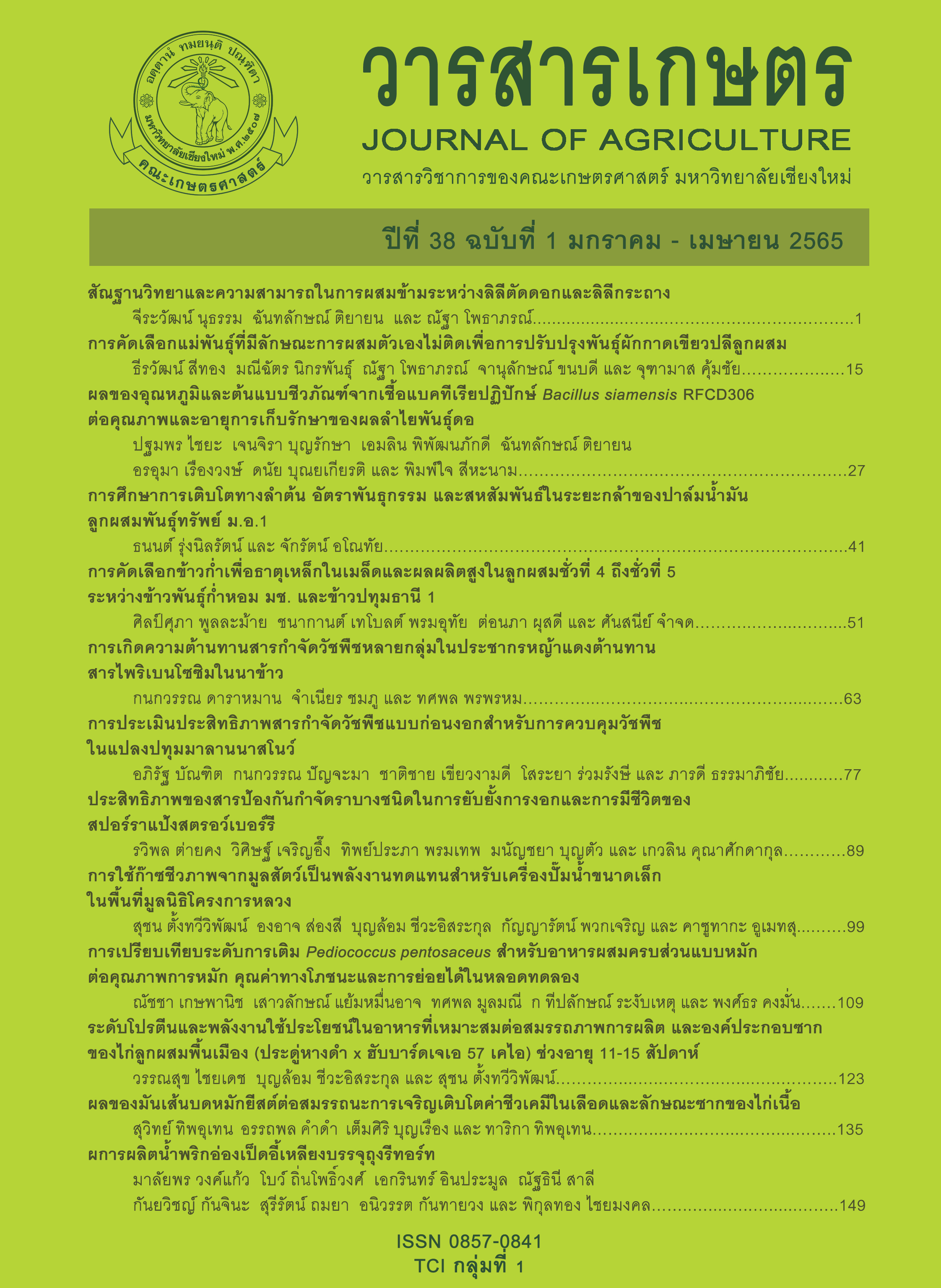ประสิทธิภาพของสารป้องกันกำจัดราบางชนิดในการยับยั้งการงอกและการมีชีวิตของสปอร์ราแป้งสตรอว์เบอร์รี
Main Article Content
บทคัดย่อ
การศึกษาการยับยั้งการงอกและการมีชีวิตของสปอร์ราแป้งสตรอว์เบอร์รี มีวัตถุประสงค์เพื่อประเมินประสิทธิภาพของสารป้องกันกำจัดรา 2 กลุ่ม รวม 11 กรรมวิธี คือ ประเภทสัมผัส ได้แก่ electrolyzed oxidized water (EOW), sulfur, aliphatic hydrocarbon, sodium bicarbonate และ mancozab และประเภทดูดซึม ได้แก่ azoxystrobin, difenoconazole + azoxystrobin, triforine, metalaxyl, penthiopyrad และ carbendazim โดยใช้
ในอัตราแนะนำสูงสุด และมีน้ำกลั่นฆ่าเชื้อเป็นกรรมวิธีควบคุม ผลการทดลองหลังบ่มสปอร์ราแป้งบนเยื่อหอมที่แช่ในสารละลายสารป้องกันกำจัดราแต่ละชนิดที่ระยะเวลา 6, 12, 18 และ 24 ชั่วโมง หลังการปลูกเชื้อ ให้ผลในทำนองเดียวกัน โดยการทดลองที่ 24 ชั่วโมง พบว่า สารป้องกันกำจัดราที่สามารถยับยั้งการงอกของสปอร์ราแป้งได้ไม่แตกต่างกันทางสถิติ โดยมีค่าสูงสุดที่ 99-100% ได้แก่ EOW, sulfur, aliphatic hydrocarbon, mancozeb, difenoconazole + azoxystrobin, triforine, metalaxyl และ penthiopyrad และเมื่อนำสปอร์ในแต่ละกรรมวิธีมาย้อมด้วย FDA เพื่อตรวจสอบความมีชีวิตภายใต้กล้อง inverted fluorescent พบว่า EOW, sulfur และ aliphatic hydrocarbon มีประสิทธิภาพไม่แตกต่างกันทางสถิติในการทำให้สปอร์ตายและสอดคล้องกับการยับยั้งการงอกที่สูงที่สุด แต่พบว่า mancozab แม้จะสามารถยับยั้งการงอกได้ถึง 99.81% แต่พบการตายของสปอร์เพียง 54.43% ส่วนกรณี sodium bicarbonate และ metalaxyl แม้จะสามารถยับยั้งการงอกได้ค่อนข้างสูงที่ 78.35 และ 86.01% ตามลำดับ แต่พบว่าไม่สามารถลดความมีชีวิตของสปอร์ราแป้งได้ แสดงให้เห็นว่าสารป้องกันกำจัดราบางชนิดอาจมีผลในการชะลอการเข้าทำลายของเชื้อราแป้งด้วยการยับยั้งการงอกของสปอร์แต่อาจไม่สามารถควบคุมการเกิดโรคได้อย่างมีประสิทธิภาพเนื่องจากไม่สามารถยับยั้งการมีชีวิตของสปอร์ได้
Article Details

อนุญาตภายใต้เงื่อนไข Creative Commons Attribution-NonCommercial-NoDerivatives 4.0 International License.
เอกสารอ้างอิง
Ale-Agha, N., H. Boyle, U. Braun, H. Butin, H. Jage, V. Kummer and H.D. Shin. 2008. Taxonomy, host range, and distribution of some powdery mildew fungi (Erysiphales). Schlechtendalia 17: 39-54.
Anand, T., A. Chandrasekaran, S. Kuttalam, G. Senthilraja and R. Samiyappan. 2010. Integrated control of fruit rot and powdery mildew of chilli using the biocontrol agent Pseudomonas fluorescens and a chemical fungicide. Biological Control 52(1): 1-7.
Boonmee, S. and K. Kunasakdakul. 2013. Effects of electrolyzed oxidizing water on powdery mildew reduction of cucurbits. Journal of Agriculture 29(3): 257-266. (in Thai)
Boyd, V., O.M. Cholewa and K.K. Papas. 2008. Limitations in the use of fluorescein diacetate/propidium iodide (FDA/PI) and cell permeable nucleic acid stains for viability measurements of isolated islets of Langerhans. Current Trends in Biotechnology and Pharmacy 2(2): 66-84
Braun, U. 1985. Miscellaneous notes on the genus Sphaerotheca. I. Zentralblatt für Mikrobiologie 140(2): 161-170.
Calis, O., C. Cekic, S. Soylu and M. Tor. 2015. Identification of new resistance sources from diploid wild strawberry against powdery mildew pathogen. Pakistan Journal of Agricultural Sciences 52(3): 677-683.
Demir, S., A. Gül and E. Onogur. 1997. The effect of sodium bicarbonate on powdery mildew in tomato. Acta Horticulturae 491: 449-452.
Fallik, E., O. Ziv, S. Grinberg, S. Alkalai and J. D. Klein. 1997. Bicarbonate solutions control powdery mildew (Leveillula taurica) on sweet red pepper and reduce the development of postharvest fruit rotting. Phytoparasitica 25(1): 41-43.
Glawe, D.A. 2006. Synopsis of genera of Erysiphales (powdery mildew fungi) occurring in the Pacific Northwest. Pacific Northwest Fungi 1(12): 1-27.
Hiremath, B. and A.A. Lal. 2018. Evaluation of fungicides for management of field pea (Pisum sativum L.) powdery mildew caused by Erysiphe polygoni DC. International Journal of Pure and Applied Bioscience 6(4): 516-520.
Kakade, D.S., S.B. Gurav, B.R. Singh and C.A. Nimbalker. 2006. Management of powdery mildew in rose under polyhouse condition. Journal of Ornamental Horticulture 9(4): 293-295.
Keinath, A.P. 2015. Efficacy of fungicides against powdery mildew on watermelon caused by Podosphaera xanthii. Crop Protection 75: 70-76.
Kim, C., Y.C. Hung and R.E. Brackett. 2000. Roles of oxidation–reduction potential in electrolyzed oxidizing and chemically modified water for the inactivation of food-related pathogens. Journal of Food Protection 63(1): 19-24.
Lee, S.Y., S.B. Lee, Y.K. Kim and H.G. Kim. 2004. Effect of agrochemicals on mycelial growth and spore germination of a hyperparasite, Ampelomyces quisqualis 94013 for controlling cucumber powdery mildew. The Korean Journal of Pesticide Science 8(1): 71-78.
Maas, J.L. 1998. Compendium of Strawberry Diseases. 2nd ed. U.S. American Phytopathological Society, St. Paul, MN. 98 p.
Meeboon, J., I. Hidayat and S. Takamatsu. 2016. Note on powdery mildews (Erysiphales) in Thailand I. Podosphaera sect. Sphaerotheca. Plant Pathology and Quarantine 6(2): 142-174.
Paulus, A and J. Nelson. 1988. Controlling powdery mildew and rust in roses. California Agriculture 42(4): 15.
Reid, I.D. and K.A. Seifert. 1982. Effect of an atmosphere of oxygen on growth, respiration, and lignin degradation by white-rot fungi. Canadian Journal of Botany 60(3): 252-260.
Reuveni, M. and D. Sheglov. 2002. Effects of azoxystrobin, difenoconazole, polyoxin B (polar) and trifloxystrobin on germination and growth of Alternaria alternata and decay in red delicious apple fruit. Crop Protection 21(10): 951-955.
Tammasorn, N., N. Wanasiri, W. Kuntasup, R. Cheewangkoon, R.J. McGovern and C. To-Anun. 2017. Controlling powdery mildew disease of Craterostigma pumilum Hochst. ornamental plant. International Journal of Agricultural Technology 13(2): 213-226.


